Abstract [View PDF] [Read Full Text]
Objective
To explore the inhibitory effect of long non-coding RNA (lncRNA) KCNQ1 overlapping transcript 1 (KCNQ1OT1) by targeting microRNA-199a-5p (miR-199a-5p) on the apoptosis of human lens epithelial cells (LECs).
Methods
The anterior lens capsule tissue of 23 age-related cataract patients who underwent cataract surgery in Xinxiang First People’s Hospital from December 2018 to August 2019 was collected.At the same time, anterior lens capsules from 20 healthy donor were collected.The expressions of KCNQ1OT1 and miR-199a-5p in the tissues were detected by real-time fluorescence PCR.Human LECs SRA01/04 cultured in vitro were divided into blank control group, model control group, small interfering RNA-negative control (siR-NC) group, siR-KCNQ1OT1 group, miR-NC group, miR-199a-5p group, siR-KCNQ1OT1+ anti-miR-NC group and siR-KCNQ1OT1+ anti-miR-199a-5p group.No intervention was administered to blank control group.Cells in model control group were cultured with 100 μmol/L H2O2 for 24 hours to establish oxidative stress injured model, and cells in the other six groups were transfected with corresponding transfection reagents for 6 hours by liposome method according to grouping, and then treated with 100 μmol/L H2O2 for 24 hours.The expressions of KCNQ1OT1 and miR-199a-5p in lens anterior capsule tissue and LECs cells were determined by real-time fluorescent quantitative PCR.Cell viability was detected with thiazolyl blue (MTT). Cell apoptosis was analyzed by flow cytometry.The expressions of B-cell lymphoma/leukemia-2 (bcl-2) and bcl-2 related X protein (Bax) proteins were assayed by Western blot.The superoxide dismutase (SOD) activity and malondialdehyde (MDA) content were measured by enzyme-linked immunosorbent assay (ELISA). The targeting relationship between KCNQ1OT1 and miR-199a-5p was verified by dual luciferase reporter experiment.The study protocol was approved by an Ethics Committee of Xinxiang First People’s Hospital (No.2019-001). Written informed consent was obtained from relatives of patient.
Results
The relative expression of KCNQ1OT1 in the anterior capsule of patients with age-related cataract was 2.41±0.42, which was significantly higher than 0.97±0.19 of normal people, and the relative expression of miR-199a-5p in the capsule of patients with age-related cataract was 0.36±0.12, which was lower than 1.04±0.15 of normal people, and the differences were statistically significant (t=14.112, 16.507; both at P<0.001). Compared with blank control group, the relative expressions of KCNQ1OT1 and bax protein, cell apoptosis rate and MDA content were significantly increased, and the relative expressions of miR-199a-5p and bcl-2 protein, cell viability and SOD activity were significantly reduced in model control group, showing statistically significant differences (all at P<0.001). Compared with siR-NC group, the relative expressions of KCNQ1OT1 and bax protein, cell apoptosis rate and MDA content in cells of siR-KCNQ1OT1 group were decreased, while the relative expression of bcl-2 protein, cell survival rate and SOD activity were increased, and the differences were statistically significant (all at P<0.05). Compared with miR-NC group, the KCNQ1OT1-wild type (WT) luciferase activity in miR-199a-5p group was significantly decreased, with a statistically significant difference (t=21.131, P<0.001). The relative expression levels of miR-199a-5p and bcl-2 proteins, cell survival rate and SOD activity were significantly increased, and the relative expression of bax protein, cell apoptosis rate and MDA content were significantly decreased in miR-199a-5p group than those in miR-NC group, and the differences were statistically significant (all at P<0.05). The relative expression levels of miR-199a-5p and bcl-2 proteins, cell survival rate and SOD activity were significantly lower, and the cell apoptosis rate, relative expression of bax protein and MDA content were significantly higher in siR-KCNQ1OT1+ anti-miR-199a-5p group than those in siR-KCNQ1OT1+ anti-miR-NC group, and the differences were statistically significant (all at P<0.05).
Conclusions
The inhibition of KCNQ1OT1 can promote the cell viability of human LECs, inhibit H2O2-induced cell apoptosis and oxidative stress, and the mechanism may be related to the up-regulation of miR-199a-5p.
Key words:
Figures and tables


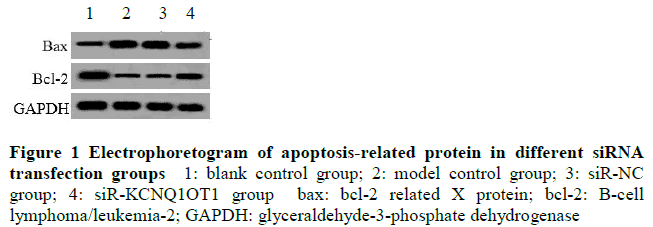
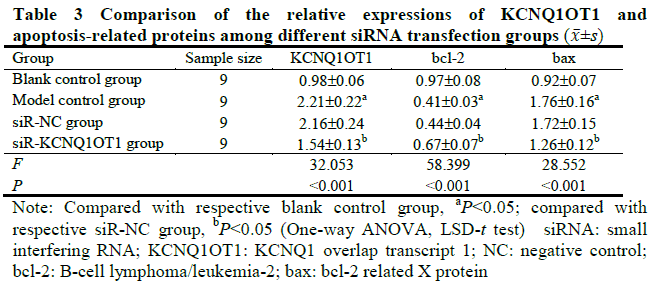





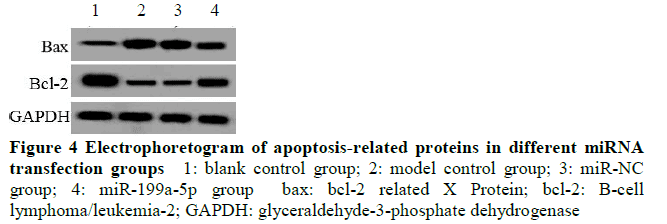
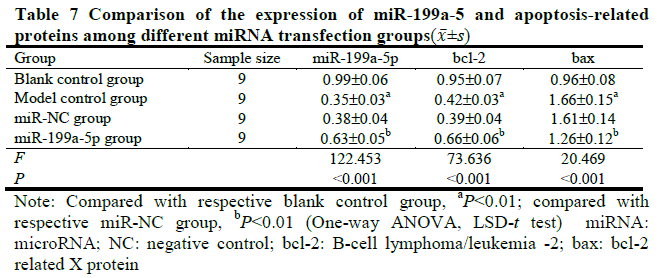
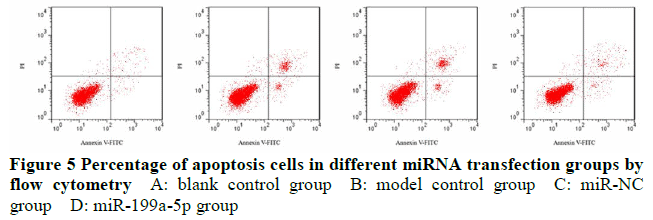





Contributor Information
Department of Ophthalmology, Xinxiang First People’s Hospital, Xinxiang 453000
Department of Ophthalmology, the First Affiliated Hospital of Zhengzhou University, Zhengzhou 450000, China
Department of Ophthalmology, the First Affiliated Hospital of Zhengzhou University, Zhengzhou 450000, China
Department of Ophthalmology, Xinxiang First People’s Hospital, Xinxiang 453000